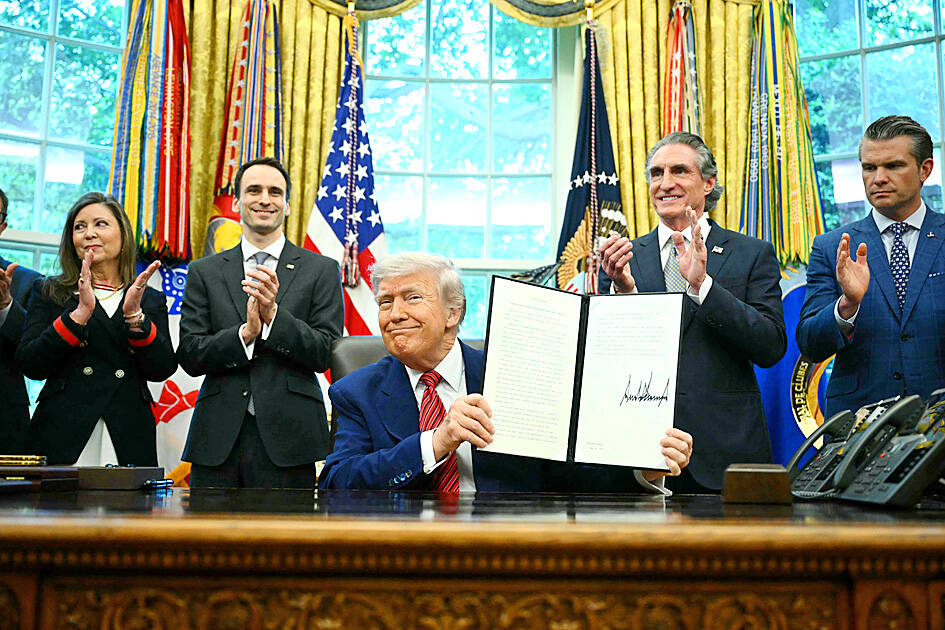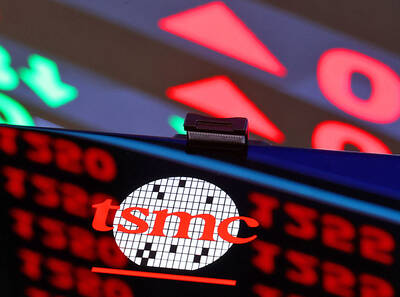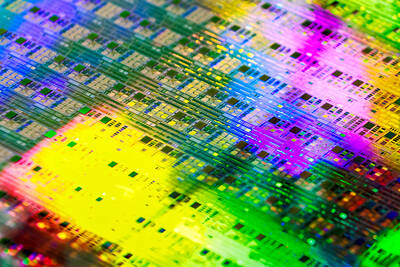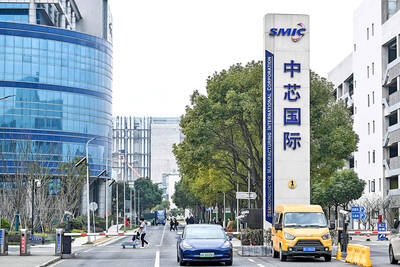Investors were growing optimistic that US President Donald Trump’s trade wars had started to calm down. His latest tariff broadsides quickly disabused them of that notion.
Initial agreements with the UK and China buoyed hopes on Wall Street and in corporate boardrooms that the US president was starting to peel back the highest US tariffs in nearly a century.
However, Friday delivered a harsh reminder of Trump’s volatile policymaking and penchant for brinkmanship, when he threatened a 50 percent tariff on the EU and a 25 percent levy on smartphones if companies including Apple Inc and Samsung Electronics Co failed to move production to the US.

Photo: AFP
Equities fell across the globe, the US dollar slumped to its lowest level since 2023 and business leaders were left to grapple with the notion that Trump-generated uncertainty is here to stay.
“Today’s news that Trump is threatening enormous tariffs on the EU and is singling out Apple as a firm are examples of what we should expect for the next two months if not for the rest of the year,” Peterson Institute for International Economics executive vice president Marcus Noland said. “Peace has not broken out.”
A White House official said that the US president was hoping to sign more trade agreements with some major economies and then fast-track deals with others during a 90-day pause on his tariffs announced on April 2.
Some arrangements are said to be close, including one with India, US Secretary of the Treasury Scott Bessent told Fox News on Friday.
Business leaders and consumers would be watching carefully for next steps. The US president’s Friday directive on the EU offered a preview of what he said his administration might do with dozens of trading partners seeking lower duties: Simply dictate tariff levels.
Trump ally Steve Bannon said the president’s reaction was in part due to what he saw as a lack of progress on trade issues last week at a G7 finance ministers meeting, particularly given the relatively quick deal he was able to strike with the UK.
Other countries without deals in progress should be worried, Bannon said, calling it a “storm warning.”
Trump seemed as committed to tariffs as ever. He threw his support behind a partnership between US Steel Corp and Japan’s Nippon Steel Corp, crediting his tariffs for finalizing the pact that had been in the works for years. That announcement came as Japanese trade negotiators were holding talks with US trade officials in Washington.
When Trump paused his higher April 2 tariffs, he left in place a 10 percent charge on most trading partners. Separate levies on steel, aluminum and autos remain. Trump has also promised a range of new import taxes on copper, semiconductor chips, pharmaceutical drugs, lumber and aircraft parts — all of which could drive up the total effective tariff rate.
At the same time, Trump showed a willingness to negotiate on duties imposed on specific sectors when the US and UK agreed to negotiate new rates on metals.
Tariff levels remain uncertain, but “will probably remain elevated for the foreseeable future,” Goldman Sachs Group Inc analysts wrote in a note on May 14.
The bank forecast that the effective US tariff rate would rise by 13 percentage points this year, to the highest level since the 1930s.
It could all be for naught, with Goldman saying “higher bilateral tariffs are unlikely to drive a substantial increase in domestic production,” a stated goal of Trump.
Talks are advancing with other partners including India, Japan, Vietnam and Israel. Some short-term relief could be possible, but the threat of fresh trade feuds is widespread across several countries.
Trump’s penchant for out-of-nowhere threats, even on countries with which the US has trade agreements, sows doubt in the longevity of any deal he strikes, Noland said.
“It’s really quite extraordinary that we had free-trade agreements with some of these countries — South Korea, Australia — and they’re just getting hit with tariffs,” Noland said. “His willingness to tear up previous agreements and ignore them has to be highly concerning for other countries.”

SEMICONDUCTOR SERVICES: A company executive said that Taiwanese firms must think about how to participate in global supply chains and lift their competitiveness Taiwan Semiconductor Manufacturing Co (TSMC, 台積電) yesterday said it expects to launch its first multifunctional service center in Pingtung County in the middle of 2027, in a bid to foster a resilient high-tech facility construction ecosystem. TSMC broached the idea of creating a center two or three years ago when it started building new manufacturing capacity in the US and Japan, the company said. The center, dubbed an “ecosystem park,” would assist local manufacturing facility construction partners to upgrade their capabilities and secure more deals from other global chipmakers such as Intel Corp, Micron Technology Inc and Infineon Technologies AG, TSMC said. It

NO BREAKTHROUGH? More substantial ‘deliverables,’ such as tariff reductions, would likely be saved for a meeting between Trump and Xi later this year, a trade expert said China launched two probes targeting the US semiconductor sector on Saturday ahead of talks between the two nations in Spain this week on trade, national security and the ownership of social media platform TikTok. China’s Ministry of Commerce announced an anti-dumping investigation into certain analog integrated circuits (ICs) imported from the US. The investigation is to target some commodity interface ICs and gate driver ICs, which are commonly made by US companies such as Texas Instruments Inc and ON Semiconductor Corp. The ministry also announced an anti-discrimination probe into US measures against China’s chip sector. US measures such as export curbs and tariffs

The US on Friday penalized two Chinese firms that acquired US chipmaking equipment for China’s top chipmaker, Semiconductor Manufacturing International Corp (SMIC, 中芯國際), including them among 32 entities that were added to the US Department of Commerce’s restricted trade list, a US government posting showed. Twenty-three of the 32 are in China. GMC Semiconductor Technology (Wuxi) Co (吉姆西半導體科技) and Jicun Semiconductor Technology (Shanghai) Co (吉存半導體科技) were placed on the list, formally known as the Entity List, for acquiring equipment for SMIC Northern Integrated Circuit Manufacturing (Beijing) Corp (中芯北方積體電路) and Semiconductor Manufacturing International (Beijing) Corp (中芯北京), the US Federal Register posting said. The

India’s ban of online money-based games could drive addicts to unregulated apps and offshore platforms that pose new financial and social risks, fantasy-sports gaming experts say. Indian Prime Minister Narendra Modi’s government banned real-money online games late last month, citing financial losses and addiction, leading to a shutdown of many apps offering paid fantasy cricket, rummy and poker games. “Many will move to offshore platforms, because of the addictive nature — they will find alternate means to get that dopamine hit,” said Viren Hemrajani, a Mumbai-based fantasy cricket analyst. “It [also] leads to fraud and scams, because everything is now